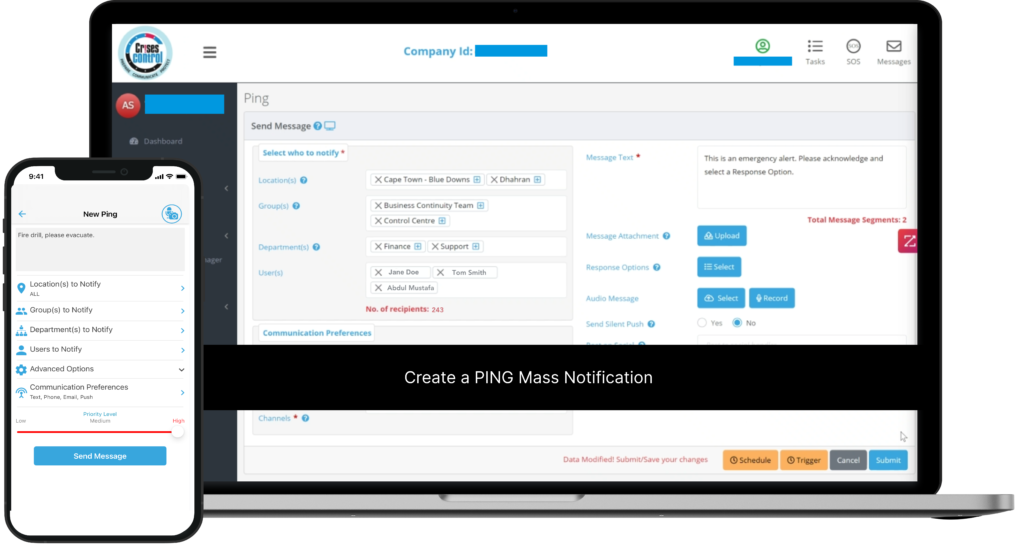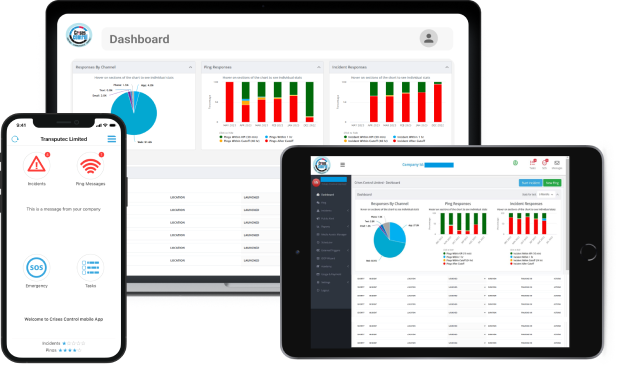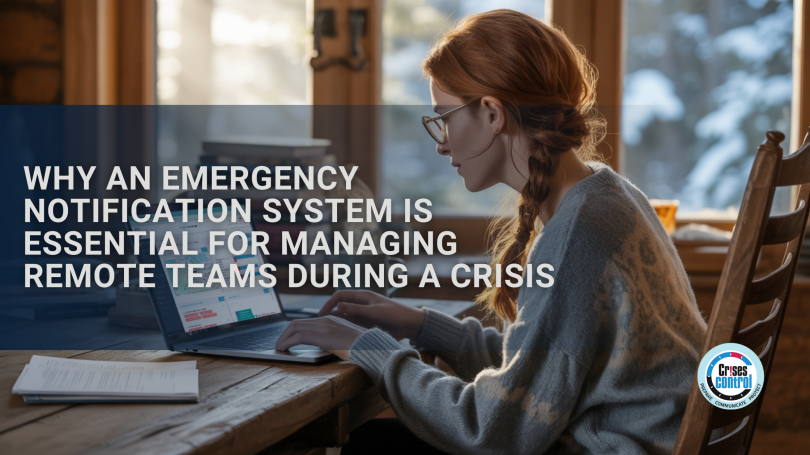Written by Anneri Fourie | Crises Control Executive
When a crisis strikes, whether it’s a cyberattack, IT failure, or even something more disruptive like a natural disaster, the ability to communicate quickly and clearly with your remote team becomes crucial. Yet, many businesses still rely on tools like email, Slack, or WhatsApp to handle critical communications, and these just weren’t built to manage urgent situations.
In a high-pressure scenario, important messages can easily get buried in the noise of routine conversations, or worse, be missed entirely. Time is of the essence, and communication failure can lead to chaos, confusion, and even safety risks. That’s where an Emergency Notification System comes in, designed specifically to cut through the noise, ensuring your team is always in the loop and ready to act.
In this blog, we’ll explore why traditional communication tools fall short in a crisis, how an Emergency Notification System addresses these challenges, and why Crises Control is the answer to keeping your remote teams informed, safe, and prepared.
Why Traditional Communication Tools Aren’t Enough in a Crisis
We’ve all become familiar with tools like Slack, email, and WhatsApp for daily communication. But when it comes to managing an emergency, these platforms fail in several critical areas. Here’s why:
1. Speed is Critical, and Email Can’t Deliver Fast Enough
In an emergency, waiting for a message to be delivered through email can lead to delays that could cost valuable time. Many employees might not check their inbox immediately or could miss an important email entirely. If a crisis unfolds quickly, this delay can put people or operations at risk.
2. No Way to Track Who’s Received the Message
While tools like Slack can show when a message is read, there’s no built-in method for confirming that your team understands the urgency of a situation. In a crisis, you need to know if your team is fully informed and ready to act, not just if they’ve seen the message. Without clear tracking and acknowledgement, your communication could be ineffective.
3. Not Everyone Has Access to Tools 24/7
In the hustle and bustle of everyday work, employees are more likely to be constantly plugged into their communication tools. But in an emergency, workers may be away from their devices or on the move. Not everyone is always on Slack or checking email, especially if they’re in a different time zone, working odd hours, or in a situation where they can’t access these tools immediately.
4. Managing Multiple Channels Separately Can Lead to Chaos
During an emergency, you may need to send notifications across different channels; SMS, voice calls, emails, or mobile alerts. Trying to coordinate all of these through multiple platforms quickly becomes inefficient, leading to confusion, missed messages, or delays in response.
An Emergency Notification System is designed to solve these problems by providing a unified, efficient, and reliable way to reach your entire remote team with critical, time-sensitive messages.
How an Emergency Notification System Solves These Communication Challenges
An Emergency Notification System (ENS) is built to address the specific issues that arise during a crisis. Here’s how it can help your business handle emergencies with ease:
1. Instant Delivery Across Multiple Channels
Unlike email or Slack, an ENS ensures that your message is delivered instantly to your team via multiple communication channels; SMS, push notifications, voice calls, and email. This means no matter where your employees are or what device they’re using, they’ll receive the message as soon as it’s sent. The speed of delivery can be critical, especially when every minute counts.
2. Real-Time Acknowledgements and Tracking
An ENS lets you track who has received your message and who has acknowledged it. This feature allows you to instantly see which team members are informed, and who may need a follow-up. If an important evacuation notice goes out, you can see who’s responded and take action to ensure no one is left behind.
3. Automated Escalation in Case of Non-Response
One of the greatest advantages of an ENS is the ability to automatically escalate messages when there is no response. If a team member doesn’t acknowledge a critical message within a set time, the system can escalate the alert to a manager or send it through another channel, ensuring that no one is overlooked during a crisis.
4. Centralised Control and Clarity
An ENS centralises your crisis communications into one platform, meaning you can manage everything from one dashboard. This reduces the confusion of using multiple tools and ensures that your team receives clear, actionable information quickly and efficiently. A single, streamlined platform makes crisis management far simpler and more effective.
Interested in our Ping Mass Notification System?
Efficiently alert everyone in seconds at scale with our Mass Notification System – PING, get the message out fast and ensure rapid response and recovery.

Managing Remote Teams During an Emergency: The Unique Challenges
When it comes to remote teams, communication during an emergency becomes even more complex. Time zones, varying access to tools, and the spread-out nature of the team can make a crisis harder to manage. Here’s why an Emergency Notification System is the best tool to handle these challenges:
1. Ensuring Consistency Across Locations
Remote teams often work in different time zones, meaning that when an emergency occurs, some employees may already be off the clock, asleep, or in transit. With an ENS, you can ensure that every team member gets the same message, delivered at the same time, regardless of location. Consistency is crucial in an emergency, and an ENS ensures everyone is on the same page.
2. Scalable Solutions for Teams of Any Size
Whether your team is made up of 10 people or 10,000, an Emergency Notification System can scale to fit your needs. It’s easy to send alerts to specific groups or to your entire workforce, making it the ideal solution whether you’re managing a small team or a large, dispersed workforce.
3. Customisable Alerts for Different Groups
In a crisis, different teams need different types of information. An ENS allows you to send tailored alerts to various groups, employees might need safety information, managers may require operational instructions, and IT teams could need technical updates. This flexibility ensures that each group gets the information relevant to their role, without unnecessary clutter.
How an Emergency Notification System Supports Business Continuity
An Emergency Notification System is not just useful during a crisis, it’s also a key element in your overall business continuity strategy. Here’s how it helps maintain operations and keep your business running smoothly:
1. Speed and Accuracy for Quick Decision-Making
During a crisis, every moment counts. An ENS delivers real-time updates, allowing your team to respond quickly and accurately. Whether you’re informing your remote team about a building evacuation or implementing a business continuity plan, the right message, at the right time, is essential.
2. Minimising Downtime
Communication delays during a crisis often lead to downtime, whether it’s due to safety evacuations or IT disruptions. An ENS ensures that your team can receive timely updates, reducing downtime and keeping your operations moving even in the face of adversity.
3. Building Trust Through Transparent Communication
Crisis management is as much about protecting your employees as it is about protecting the business. Providing clear, consistent, and transparent communication helps build trust and reassures your team that their safety is a priority. When employees feel well-informed, they are more likely to stay calm and focused during a crisis.
How Crises Control Can Help Keep Your Remote Teams Safe During a Crisis
Crises Control offers an Emergency Notification System designed specifically to address the unique challenges of managing remote teams during a crisis. Here’s how our platform can help:
Multi-Channel Delivery for Guaranteed Reach
Our ENS ensures that critical messages are delivered instantly through SMS, mobile apps, voice calls, and email—ensuring that your remote team is always informed, no matter where they are or what device they use.
Real-Time Tracking and Monitoring
With Crises Control, you can track who has received your messages, who’s acknowledged them, and who requires further follow-up. This real-time tracking gives you the insight you need to manage your response and ensures everyone is accounted for.
Easy Integration with Your Existing Systems
Our system integrates seamlessly with your existing communication tools, meaning you can get started quickly without needing to overhaul your current systems. Automated alerts, escalation protocols, and customisable message templates make it easy to manage crisis communications.
Conclusion: Why Every Remote Team Needs an Emergency Notification System
Managing a remote team during a crisis is challenging, but with the right tools, it’s possible to act swiftly, decisively, and effectively. An Emergency Notification System provides a reliable, multi-channel solution to ensure your remote team receives critical updates in real-time, no matter where they are.
With Crises Control’s Emergency Alerting Solutions, you can ensure that your workforce is informed, safe, and prepared to act. Our platform offers instant message delivery, real-time tracking, and centralised management, helping you stay in control during any crisis.
Don’t wait until it’s too late to realise your communication systems are insufficient. Contact us today for a free demo and see how Crises Control can help you streamline your crisis communication strategy and keep your remote teams ready for anything.
Request a FREE Demo

